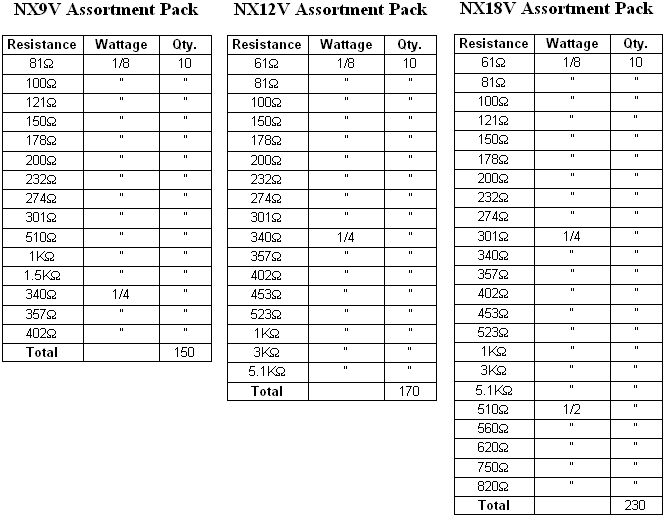Best viewed using:
Internet Explorer
or
Mozilla Firefox
Resistor Usage
What do resistors do, and why do we need them?
Resistors come in all kinds of shapes and sizes, but they all have only one purpose in life: To limit, or "resist" the flow of current.
LEDs are DC devices and will not function properly using AC (alternating current). When powering an LED, unless the voltage source exactly matches the LED device voltage, a "limiting" resistor must be used to provide the proper voltage drop and ensure the device will not be supplied with too much current. Without this limiting resistor, the LED would instantly burn out.
Watt's that... you say?
In electricity, the measurement of work performed, or the unit of power (P) is called the Watt. Without digressing too much, Ohm's Law states: P = V x I or P = IČ x R That is, Power equals Voltage times Current, or Power equals Current squared times Resistance. This formula is what our calculators use to compute Wattage values for you.
For a given supply voltage, a given resistance value will allow a given current to flow (in our case, through an LED). As current flows through the resistor, heat is generated and the resistor dissipates it away. If we reduce the resistance value or "push harder" by raising the voltage, more current will flow, and more heat will be generated (greater Power, or more Wattage).
Resistors operating near their rated wattage, run hot. In some cases hot enough to burn your fingers. If mounted against a plastic surface like the inside of a building or locomotive shell, they could cause some melting of the plastic. Definitely, not desirable. With regard to the resistor itself, they're designed to run hot and won't be physically damaged unless they are run at above their wattage rating. In that case, the solder pads on the resistor ends could even unbond and the resistor would stop functioning.
Now, if the resistor is not near (or up against) something that is heat sensitive like plastic, it will just radiate that heat off into the open air (acting like a tiny electric heater), or if it's mounted to a circuit board (soldered to the solder pads on the board), the solder pads and board will help and act as a heatsink, sucking away some of the excess heat. Placing the resistor against a larger piece of metal will act as a heatsink but the resistor must be electrically insulated from the metal so it doesn't short out (which would defeat the purpose of the resistor). A thin piece of Kapton tape can work well for this purpose because it can handle fairly high temperature and is an excellent insulator.
As we said earlier, "resistors operating near their rated wattage". To examine this more closely, let's use one of our 2x3 Super-white LEDs (N1021) as an example. It has a 3.6-volt device voltage. For power, we'll use our N3500 9-volt power supply which regulates its output to within 2% and the N2740 274 Ohm resistor which has a 1% tolerance. Now, let's look at a worst-case scenario:
The power supply could have an output of 9.18 volts (2% above 9.0), and the resistor could have a value of 271.3 ohms (99% of 274). Using those values in our LED current calculator, the LED would get 20.6 ma (that little bit extra won't overdrive the LED), but the resistor will have to dissipate 116 milliwatts. The rating of the N2740 is 1/8 watt or 125 milliwatts. That means we could be running that resistor very close to its maximum rating. It will work just fine, but it's going to get HOT! Ouch to the touch, HOT. If in your application, that won't be a problem, the resistor certainly won't mind. But, if what you're going to build and how you're going to locate the wiring and resistors could be a factor, the heat issue must be taken into consideration.
Besides the "heat sinking" mentioned earlier, there are two more ways to deal with the heat issue. First, we can replace the 1/8-watt unit with a larger wattage one. The next step up is 1/4 watt, and we carry a 301-ohm version. If we again use the calculator, in the worst-case situation, the 301-ohm resistor (1% tolerance) could have a value of 298 ohms. That would reduce the LED current to 18.8 milliamps, which would reduce the brightness so little the difference wouldn't be detectable. On the other hand, the calculated wattage would be 105 milliwatts running through a 250-milliwatt resistor. The resistor will still feel "kinda" hot to the touch (because it's doing what resistors do), but substantially less than in our previous example.
If space is a real issue and you aren't as concerned about getting maximum brightness output of an LED for a particular application, the second alternative is to increase the resistance value. This will reduce the current flow and therefore reduce the Power, and the heat generated. For example, using a NA5100, 510 ohm 1/8 watt resistor would allow about 11 milliamps of current to flow and the LED would be at about 55% relative brightness (still very bright by incandescent bulb standards). That would only draw 61 milliwatts of power and the resistor would be virtually cold to the touch.
The tables below list calculated resistance and wattage values for our LEDs in single (parallel) applications, and in series applications, for 9-volt, 12-volt and 18-volt power sources. The numbers shown in the * columns correspond to the Item number for the resistors shown in the table below to provide an approximate nominal current of 20ma to the LEDs. This will yield the "standard" brightness output (intensity) for each LED type. Remember, the closer the wattage values shown are to the resistor's wattage rating, the hotter the resistor will run. If you want to adjust LED brightness for specific applications, or to balance intensities between various LEDs, or to reduce current for specific wattage needs, you should use our calculators to compute your custom resistance, wattage, and LED intensity requirements.
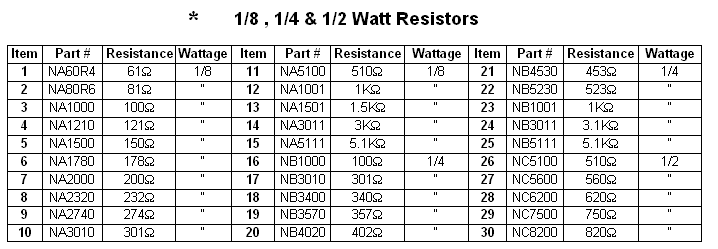
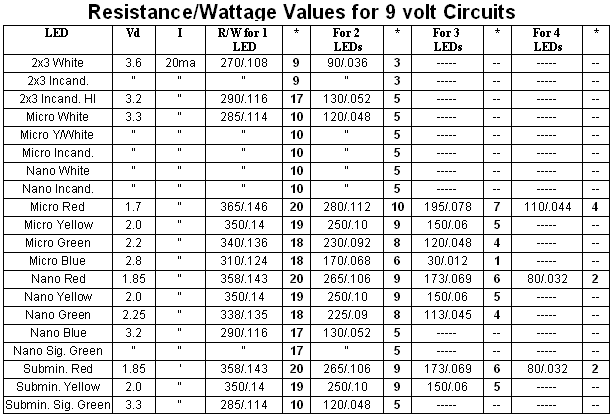
*assumes LEDs are of the same type and wired in series
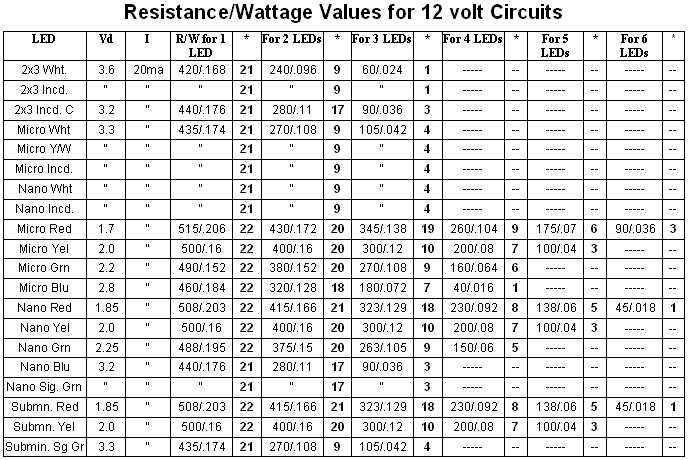
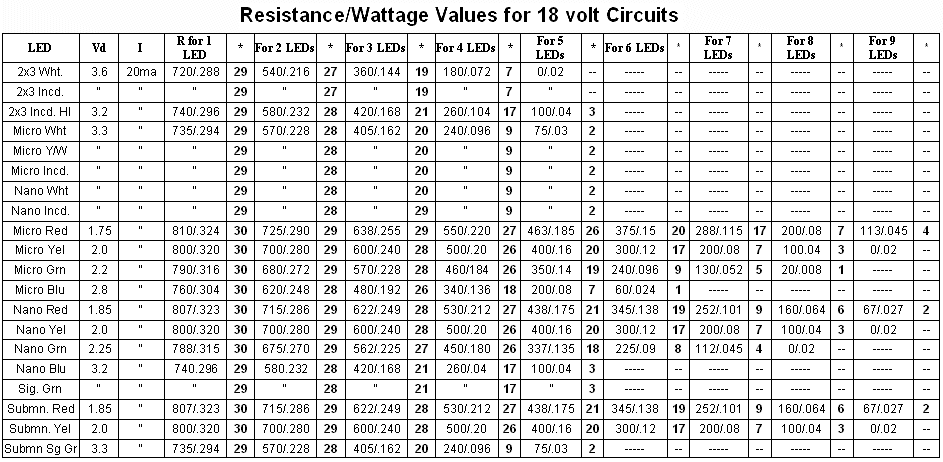
Resistor Assortment Packs
We've created three Assortment Packs of resistors for hobbyists that are planning various different projects or want to experiment with variations in LED output intensity. Each pack is an assortment of different resistor values selected as the best general grouping for our LEDs when used with a specific supply voltage. The NX9V is intended for use with a 9-volt DC power source, the NX12V with a 12-volt source, and the NX18V with a 18-volt source. Below is a detailed listing for each pack.
